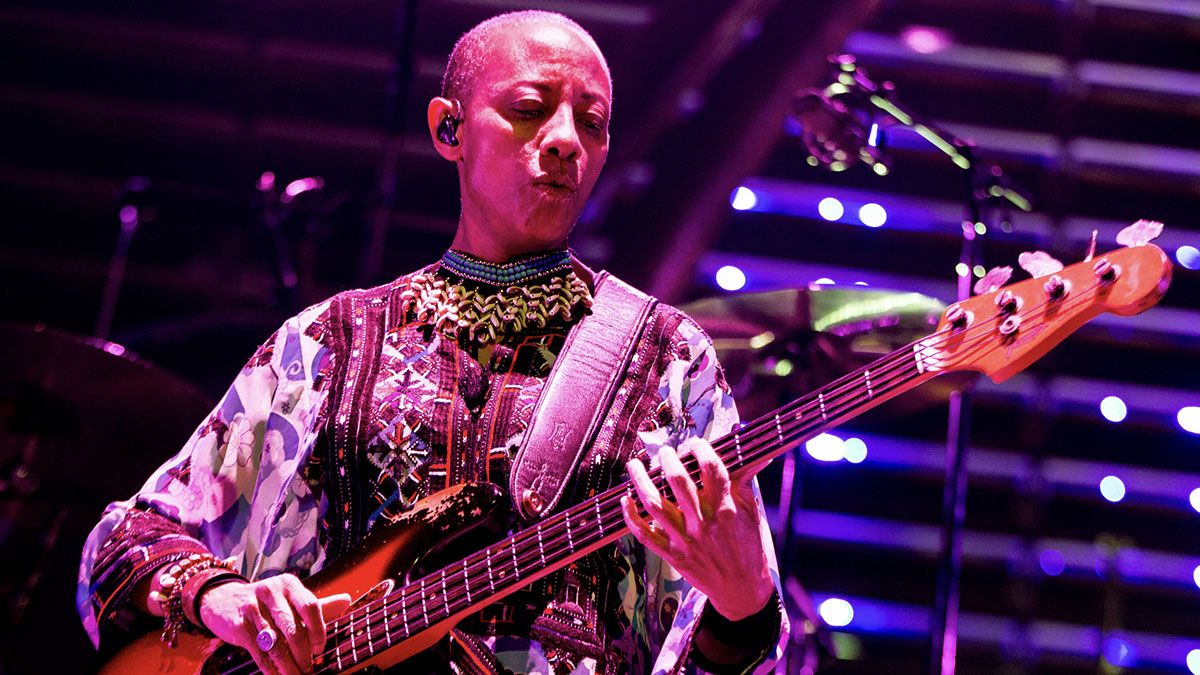Gail Ann Dorsey: “It was so much fun to work with David Bowie – he was always open to exploration of his material”
David Bowie, Lenny Kravitz, Gang of Four: the great Gail Ann Dorsey has earned Bass Player's Lifetime Achievement award many times over

Gail Ann Dorsey has been an unstoppable force in the bass-playing since the '80s, when she first came to prominence as a solo and session artist.
A long and prolific sojourn with David Bowie brought her to international attention, and she has since built a long list of collaborations worldwide.
Congratulations on your award, Gail.
“I’m flabbergasted! I so appreciate this, and to be in the company of some of the others who have had this honor before... my goodness. I’m one of those people that feels like I’m not quite so worthy, but I will say that I’ve dedicated my life to the bass. I have tried to represent everything positive about the instrument. I stumbled upon it by accident, you know, and it became the greatest thing I ever did in my life other than singing.”
Is David Bowie the musician you’re most associated with, do you think?
“I think so, yes. It was so much fun to work with him, because he was always open to exploration of his material. I’m there to serve the song, but given that freedom as a bass player to participate in the music was just great. It was the greatest blessing of my life. If it can be true that one person can change the whole trajectory of your life, he certainly did mine, and in such a powerful way.”
Did Bowie have suggestions about your bass parts?
Get The Pick Newsletter
All the latest guitar news, interviews, lessons, reviews, deals and more, direct to your inbox!
“Sometimes he had a suggestion. If he had a specific thing he wanted to hear, he would ask for it or try to explain it. He would maybe have a vocal melody and some kind of drum machine and some chords – pretty rudimentary things. Within that, he might hear a line: for example, there was a song that we did for the Long Live Tibet album (1997) called Planet Of Dreams. There’s a bass part at the beginning that he had in his mind.
“I would never have thought of it, because there’s nothing else going on there to indicate to do that, but he was like, ‘Do this little thing at the front’ – and then after that I was free to figure out how I wanted to approach the song.”
Each artist I’ve worked for has taught me another facet of how to approach the bass, and that’s always exciting
On the other hand, you also worked with Lenny Kravitz, who is an accomplished bass player himself.
“When it comes to the bass part, Lenny is completely the opposite – he wants it to sound exactly like he did it! And that’s a challenge sometimes, but it’s really fun for me, because I discovered so much. You know, playing for lots of different people has been the best education for me as a bass player, because I never went to school to study bass.
“I can’t read music, I don’t know theory, I don’t know harmony, I don’t understand how to apply all that stuff – so it’s all my ears and patterns in my own visual kind of way. But each artist I’ve worked for has taught me another facet of how to approach the bass, and that’s always exciting. It’s been really like going to school.”
What’s an example of something you’ve learned through other artists?
“Well, something that I never thought I would do was play like a guy, you know, in the way that some men dig in really hard. Some female bassists play that way as well: Sara Lee, who is my best friend, has quite a heavy right hand when she plays bass. I’ve always had a very light touch on the bass: I don’t really dig in that much, unless I need to get a certain tone from the instrument.
“Lenny really digs in: when you listen to his tracks in isolation, you can really hear what he’s doing there. He really attacks those strings with the right hand, and I’ve never played that hard in my life. I had a lot of blisters at first, but I kind of got into it.
“A second thing that I learned from him was that you can play pretty much everything on flatwound strings. When I joined him, I said, ‘How the hell am I gonna do all this slapping with flats?’ and he said, ‘You can do it!’ He was right, and now I have flats on almost all my basses.”
Which bass gear are you currently using?
“Marilyn is my favorite bass. She’s the first StingRay that I ever had, and I’ve used her on every single job I’ve ever had, except for Lenny, because it doesn’t fit his thing – he’s a Precision and Jazz guy, because he’s a stickler for the tone. Ernie Ball gave me a reissue StingRay which came out around the year I started with Lenny, and its tone was close enough to his era that I could use it with him.
We always want to get better as a player, but I feel more confident in what I do. My hands seem to know what to do
“For amps I use Ampeg, who are always very helpful, and TC Electronic effects. I also use La Bella for flatwound strings and Ernie Ball for my roundwounds. I have some Aguilar pedals too – they have the best compressor. I use that on a lot of stuff.
“I’ve also got to mention my friend Michael Tobias of MTD basses. I have one of his basses over in Paris, and in terms of modern basses, he’s my guy. He also made my first and only fretless bass that I have, because I had to have lines on it to try and pretend that I can play it. David kind of pressed me to give fretless a go, so Michael and I built mine from scratch. I think I’ve only ever really used it on David’s stuff. Michael’s basses have the most beautiful necks – easy, flat, gorgeous, smooth.”
How are you evolving as a bass player as time passes?
“I’ve just become more comfortable with it. We always want to get better as a player, but I feel more confident in what I do. My hands seem to know what to do, and I allow it to happen instead of forcing it to happen. There’s a lesson there, I think, and not just for music, but for all kinds of things in life.”
Bass Player is the world’s most comprehensive, trusted and insightful bass publication for passionate bassists and active musicians of all ages. Whatever your ability, BP has the interviews, reviews and lessons that will make you a better bass player. We go behind the scenes with bass manufacturers, ask a stellar crew of bass players for their advice, and bring you insights into pretty much every style of bass playing that exists, from reggae to jazz to metal and beyond. The gear we review ranges from the affordable to the upmarket and we maximise the opportunity to evolve our playing with the best teachers on the planet.
“I asked him to get me four bass strings because I only had a $29 guitar from Sears”: Bootsy Collins is one of the all-time bass greats, but he started out on guitar. Here’s the sole reason why he switched
“I got that bass for $50 off this coke dealer. I don’t know what Jaco did to it, but he totally messed up the insides!” How Cro-Mags’ Harley Flanagan went from buying a Jaco Pastorius bass on the street to fronting one of hardcore’s most influential bands











